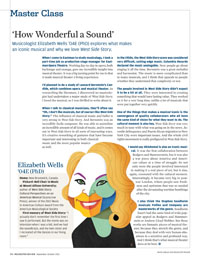Master Class
 (Photo: David Cowles for Rochester Review)
(Photo: David Cowles for Rochester Review)When I came to Eastman to study musicology, I took a part-time job as production stage manager for Eastman Opera Theatre. Working day-to-day in opera, both backstage and onstage, gave me incredible insight into musical theater. It was a big turning point for me in that it made musical theater a living experience.
I’d planned to do a study of Leonard Bernstein’s Candide, which combines opera and musical theater. In researching the literature, I discovered no musicologist had undertaken a major study of West Side Story. I loved the musical, so I was thrilled to write about it.
When I talk to classical musicians, they’ll often say “Oh, I don’t like musicals, but of course I like West Side Story.” The influence of classical music and ballet is very strong in West Side Story. And Bernstein was an incredibly facile composer. He was able to assimilate an incredible amount of all kinds of music, and it comes out in West Side Story in all sorts of interesting ways. It’s creative reworking of gestures that have become important and interesting in both classical music and the more popular musics as well.
Elizabeth Wells ’04E (PhD)
Home: New Brunswick, Canada
Pickard–Bell Chair in Music at Mount Allison University; author of West Side Story: Cultural Perspectives on an American Musical (Scarecrow Press), winner of the 2012 Music in American Culture Award from the American Musicological Society
First memory of West Side Story: “I actually don’t remember the first time I saw it performed. But the movie was on television when I was a kid. And we had the soundtrack, and my twin sister and I recreated all the dances in our living room.”
In the 1950s, the West Side Story score was considered very difficult, cutting-edge music. Columbia Records declared the music unsingable. Now people go about singing it all the time. Bernstein was a great melodist and harmonist. The music is more complicated than in many musicals, and I think that appeals to people whether they understand that complexity or not.
The people involved in West Side Story didn’t expect it to be a hit at all. They were interested in creating something that would have lasting value. They worked on it for a very long time, unlike a lot of musicals that were put together very quickly.
One of the things that makes a musical iconic is the convergence of quality collaborators who all have the same kind of vision for what they want to do. The cultural moment is also key. West Side Story was very much in tune with what was going on in the news. Juvenile delinquency and Puerto Rican migration to New York City were important issues. And the whole civil rights movement is really prefigured in West Side Story.
I would say Oklahoma! is also an iconic musical. It was the first collaboration between Rodgers and Hammerstein, but it was also a war piece about America and American values at a time of struggle. So not only were the people involved interested in making it a real piece of art, but it also, again, resonated with the cultural moment. Interestingly, it became very big in postwar London, where people saw freshness and optimism that was so needed after the devastating wartime bombings of the city.
I also think the Stephen Sondheim musicals Follies and Company are masterworks of the genre. Sondheim hasn’t had the same kind of wide popular appeal as Rodgers and Hammerstein or Andrew Lloyd Webber. But these works are fantastic pieces of musical theater, because they stretch the genre, and because they deal with very human situations in a sensitive and profound way. And I think that’s what musical theater does at its best.r

